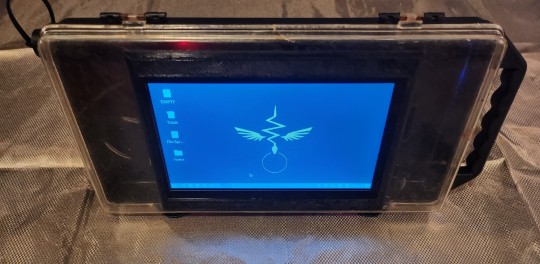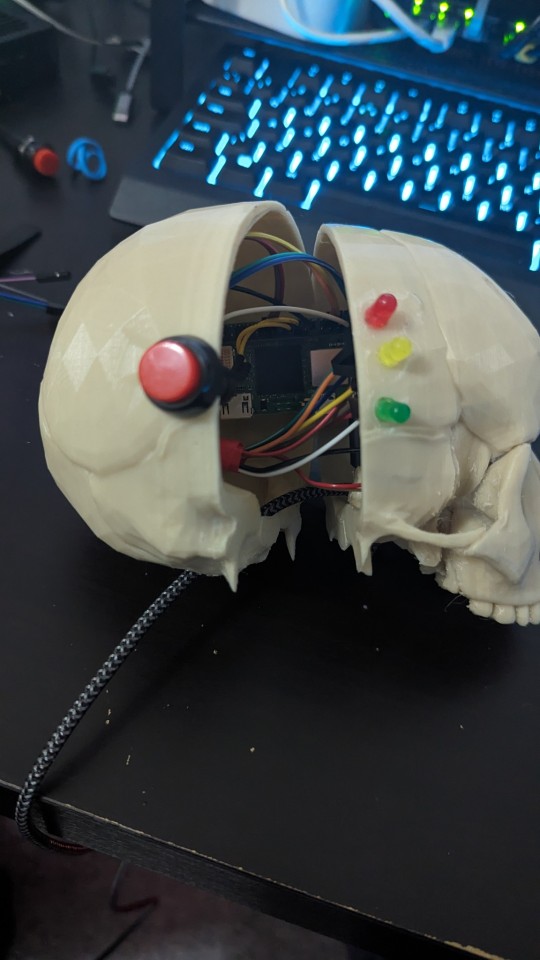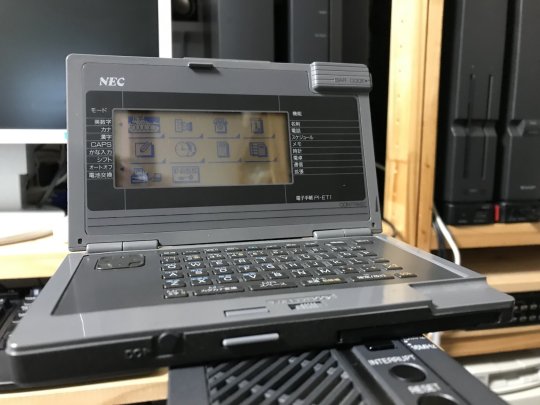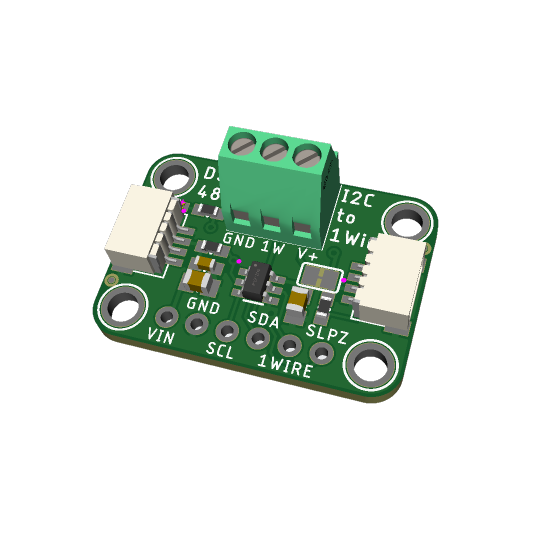#pi electronics
Explore tagged Tumblr posts
Text

PI11 [π11] JK Flesh
#pi electronics#jk flesh#javiar#dark#experimental#electronic#art#industrial#techno#collage#justin k broadrick
31 notes
·
View notes
Text

JK Flesh - PI11.3 from: JK Flesh - PI11 (Pi Electronics, 2024)
28 notes
·
View notes
Text
0 notes
Text


[CYBERDECK PROJECT ACTUAL NAME YELIEL ONLINE]
My cyberdeck is functional, I included an internal shot as well. I have plans on adding a power switch to the front cover, a retractable USB cable (EG Ghost in the Shell), a modular system for the back to house Extra Battery banks and other accessories. This project was a long time coming and instead of 3d printing a shell I found that this container I had full of sharpies was a suitable housing and adds to the "Jank" Factor. I also plan on stickerbombing the back, possibly a hanging charm, and possible LED lights inside the housing.
203 notes
·
View notes
Text

IT CAME
#makerspace#electronics#furry#clockworkpi#uconsole#raspberry pi#you shou yan#fabulous beasts#after EIGHT LONG MONTHS
16 notes
·
View notes
Text
Servo skull integration is underway!
I have run a few tests and the core functionality seems to be working fine - so I can press the button and it'll take a picture with the camera embedded in the left eye socket, briefly illuminating an led that's in the right eye socket and playing a buzzer briefly.
The green led turns on when the program I wrote is running, and if it's connected to a network the orange led will also turn on(so I can tell whether it's accessible to get the pictures off of it)
So it should be all good for MCM London on Saturday at this rate, just need to check that the cranial casing for the left hand side won't affect the picture too much


Had to remove the environment sensor as it didn't like that it was being powered from a power bank - so no temperature alert when it gets too hot for me(It was going to light up the remed if the temperature got above 30°)
Also had to take off the programmable RGB array, as whoever wired that integrated circuit was clearly on a great many things when they designed it - Trying to just access specified lights was madness. The first led was accessed through (0,1) whilst the 2nd was (1,1) and the third (6,0). And having all of them on made it looks like the skull was about to self-destruct with how bright they are
#warhammer 40k#warhammer#warhammer 40000#adeptus mechanicus#admech#cosplay#warhammer cosplay#3d printing#raspberry pi#electronics#mcm london
85 notes
·
View notes
Text



Obsessed with Max's apartment in Pi (1998)
38 notes
·
View notes
Text

38 notes
·
View notes
Text

my baby boy from the free pile at vcf
#vcf east#tiger electronics#mio#botblr#vcf#his name is hal#gonna give him a good scrubbing and then gut him and maybe put a raspberry pi in there. or something
11 notes
·
View notes
Text
LED control system in progress!!!
12 notes
·
View notes
Text

DS2484 I2C to 1-Wire converter
In theory, there's a lot of 1-Wire devices out there, but in reality almost everyone uses 1-Wire for DS18b20 temperature sensors. the long wire lengths and ease of 'chaining' by sharing a single bus wire makes it perfectly fine for this purpose. you can bitbang 1Wire on most microcontrollers, and some SBCs like Raspberry Pi have kernel module support. (https://learn.adafruit.com/adafruits-raspberry-pi-lesson-11-ds18b20-temperature-sensing) But there might be chips without the 1-Wire capability, or maybe you want to use 1-Wire devices on your desktop computer or other SBC with I2C but no 1W.
by special request! this is a DS2484 (https://www.digikey.com/short/5f85v4tf) Stemma QT board that uses the newest I2C-to-1W controller chip, with ESD protection and support for split supplies. you can easily connect it to an existing I2C bus and then use the screw terminals to attach multiple DS18b20's - this library looks promising (https://github.com/pilotak/DS248X) for Arduino. Coming soon!
15 notes
·
View notes
Text
I didn’t think I’d need to say this, but apparently I do:
Don’t use the Raspberry Pi 2040 to build a DCC decoder.
It’s not really wrong, of course, and it gives you ridiculous amounts of computing power, but to get that you need miles and miles of extra components. Like a dozen of decoupling capacitors, an external oscillator, and of course an external flash memory. You can maybe do that sort of thing in H0, but for real model trains, it’s just not ideal. Pick something like an ATTiny or STM32C0 (I’ve done both for different projects): Cheap, just one or two decoupling capacitors, no external oscillator required and no external flash memory needed either.
The versions of the RP2350 with built in memory may be a better idea, once they fix the GPIO issues anyway, but still, there’s the oscillator and just way too many capacitors.
(Some of these concerns may be different if you want to add sound support, which requires more memory anyway. But I’d argue that sound in model railroads is a mistake anyway. I’ve never seen an N scale locomotive that sounds good, it’s all just an annoying expensive gimmick.)
Also while we’re at it, don’t use a cheap standard bridge rectifier. The steep slopes of the DCC signal mandate a really fast rectifier, typically Schottky diodes. This is particularly important when you have RailCom on your layout. You may need four individual diodes instead of one rectifier, but since you won’t need all the capacitors of the RP2040, you still win out in the end (it’s also typically smaller than the rather large SMD standard rectifiers).
This is a call-out post for https://github.com/gab-k/RP2040-Decoder . It’s a useful project, but it’s also far from ideal.
4 notes
·
View notes
Text
taking O-chem again and being like "idk why i struggled so much with resonance forms last time, these are pretty simple" and then i look over my old notes and see all the different rules and im like. ah. right.
#like the lone pairs can be transferred to a pi bond but only if it fulfills an octet and they delocalize in the direction of a more EN atom#so its not as cut and dry as just moving one pair of electrons to another atom#it sucks cuz i really like chemistry actually. i feel like on that basis alone it should just come easy to me lol#idk it just stresses me out lol
21 notes
·
View notes
Text
Steve Lehman & Orchestre National De Jazz — Ex Machina (Pi)

When you think big, there’s no substitute for resources. Alto saxophonist and composer Steve Lehman’s ideas are typically broad and deep, but Ex Machina is especially massive. The project combines big band jazz, spectral composition, and interactive electronics. Any one of these elements takes study and skill to master, and while Lehman has the instrumental chops and integrative intellect grasp the parts, it takes a lot of time in a well-stocked kitchen to assemble them all into something that isn’t just a lumpy influence stew. requires a lot of time in a well-stocked kitchen.
In order to pull off this project, Lehman collaborated with the Orchestre National de Jazz, a big band funded by the French government. He also involved IRCAM (the Institute for Research and Coordination in Acoustics/Musics) to incorporate electronics that respond to the live musicians in real time. After years of composing and workshopping, Lehman and his long-time American collaborators, trumpeter Jonathan Finlayson and vibraphonist Chris Dingham, joined the orchestra for eight concerts, and then settled into the studio for four days at the beginning of 2023.
The time and resources have not gone to waste. This music feels not only sui generis — the only records it really sounds like are Lehman’s earlier octet recordings — but lived-in. The exchanges between dopplering horn sections and single soloists, and the meshing between orchestrated frequencies and precisely mutating rhythms, is spot-on.
But enough about how impressive it is; what is it? Essentially, it’s a transfer of Lehman’s spectral jazz concept, in which an understanding of frequency relationships yields access to alien sounds and an engagement with rhythm concepts spanning the ages of bebop and hip-hop makes the whole thing swing, to a post-Gil Evans orchestral environment. It has plenty of big brass punch, crips rhythms, and abrupt shifts in velocity and tone, all of which create fertile opportunities for adroit soloists to assert both structure-oriented and emotion-evoking responses. Ex Machina is everything it set out to be. And if you’re looking for a recording that’ll give you new things to hear every time you play it, it is without peers.
Bill Meyer
#steve lehman#orchestre national de jazz#ex machina#pi#bill meyer#albumreview#dusted magazine#jazz#big band jazz#electronics#spectral composition#IRCAM#Bandcamp
10 notes
·
View notes
Text

Got sunvox running on the uconsole! The key is to go to the older versions and get version 2.1c because the os doesn’t have the latest glibc.
8 notes
·
View notes
Text
Since it's my birthday today, I decided to teach my servo skull to sing happy birthday to me
#26 years old#The one day a year where i acknowledge my age#warhammer 40k#warhammer#warhammer 40000#adeptus mechanicus#admech#cosplay#warhammer cosplay#3d printing#electronics#raspberry pi
25 notes
·
View notes